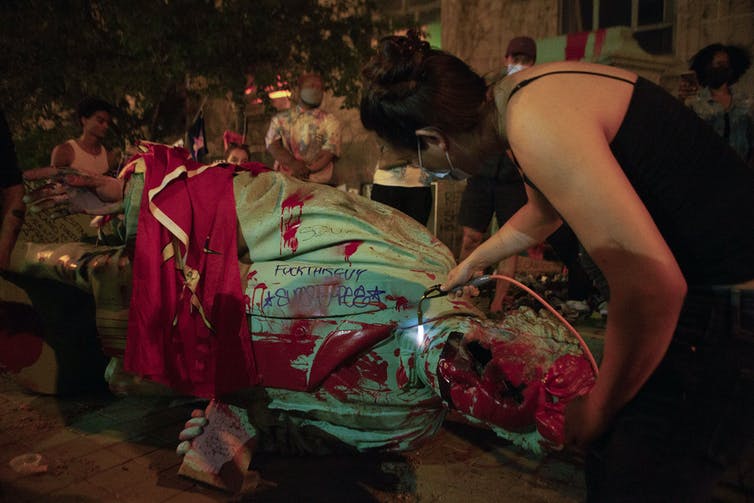By : Dino Sossi, University of Toronto
Ryerson University has a new name: Toronto Metropolitan University.
University president Mohamed Lachemi recommended the name from a list developed by a committee of professors, administrators, students and alumni. The name change process was motivated by the Mash Koh Wee Kah Pooh Win (Standing Strong) Task Force.
The university’s renaming is a welcome step in helping reconcile Canada’s long history of colonization, both past and present. It signals a willingness to make amends for Canada’s mistreatment of Indigenous people, especially in educational settings.
Ryerson’s renaming has the potential to teach important lessons across society as we strive for a more equitable future given our inequitable past.
Create a balanced history
Mash Koh Wee Kah Pooh Win focused on the university’s complex relationship with its namesake, Egerton Ryerson. His educational policies’ racist legacy devastated Indigenous communities — he was an architect for Ontario’s residential schools.
Archivists dug through records. Historians were consulted. Scholars researched. Knowledge keepers provided wisdom. And by canvassing Ryerson community members past and present, the task force reached a delicate balance.
The authors detailed Egerton Ryerson’s troubling past. They bound him to his influence in creating Ontario’s residential schools. They even shared his offensive statements on Indigenous education aims.
But the authors also highlighted Egerton’s many accomplishments. This included indigenous school fundraising and petition helping the Crown to confirm the Mississaugas’ legal title to reserves.
After the buried bodies of Indigenous children were found at former Indian residential schoolsRyerson’s statue on campus became even more harmful, traumatizing and triggering to many staff, faculty and students. His name adorning buildings, email signatures and sports teams likely did the same.
In an interview with The Globe and Mailpresident Lachemi said the new name reflects the wishes of community members:
“It’s a name that fits us perfectly. We’re located in the heart of our country’s biggest and most diverse city, so the university represents all that it means to be metropolitan. We are a gathering place for people from all over the world, from all walks of life, with broad and diverse perspectives, lived experiences and aspirations.”
Toronto Metropolitan University is expected to be in use soon but signage will take time. The blue and yellow color will remain and Ryerson will still appear on official documents until the university’s governing legislation is amended — likely after the provincial election in June.
Acknowledgment institutional inequality
Many institutions have dubious pasts. some even supported residential school atrocities, such as creating a discourse around assimilation.
We must condemn Egerton Ryerson, but acknowledge that many Canadians benefit from systems similar to the ones he helped fashion, not just education. During the pandemic, the wealthiest Canadians have prospered. In contrast, low wage workers, often women and marginalized people, have continued to suffer. The pandemic has accelerated lasting trends where seniors, people with disabilities, recent immigrants, marginalized and Indigenous people felt the most negative impacts of income inequality.
But the pandemic, Black Lives Matter and racial reckoning have also forced a kind of social reset, helping prompt the name change at Ryerson.
Mash Koh Wee Kah Pooh Win captured the sadness imperilling Ryerson’s community. The community grieved the legacy of a man they never met, but they are all too familiar with the punitive educational system he created.
We must repair public institutions that allow obscene financial and social inequality as well as personal devastation that can potentially cascade across generations. But first we must acknowledge our own role in allowing their perpetuation.
Renaming is a start
Although it could have been resisted and there was initial opposition by some groupsRyerson’s renaming speaks to how fundamental institutions like universities can listen to Indigenous people and their allies to drive welcome change.
From this, Ryerson’s renaming should not remain a symbolic act. And this achievement should not mean the battle is over. Instead, a name change means the fight has only just begun.

Scrubbing Egerton Ryerson’s name from the institution feels good. It is similar to removing his statue from the university’s grounds. But improving the worst parts of the educational policies has helped birth is better. This includes improving antiquated practices.
And Indigenous people must help lead this change. Their knowledge and culture should fully inhabit education. Some equitable education policies could include:
Public education has caused unjustifiable suffering. Many educational settings are driven by punishment, not proactive discipline. They homogenize, dehumanize and test incessantly and excessively.
Renaming public entities begins the process of repairing inequities — Ryerson is one example, Toronto’s Dundas Street is another—but it cannot end them. Regressive institutional practices must be questioned.
Chronicling past atrocities, honoring those tragically lost, incorporating survivors’ voices and building equitable institutions is the only way to build a truly inclusive society.
dino sossiInstructional Assistant, Technology and Media, University of Toronto
This article is republished from The Conversation under a Creative Commons license. Read the original article.